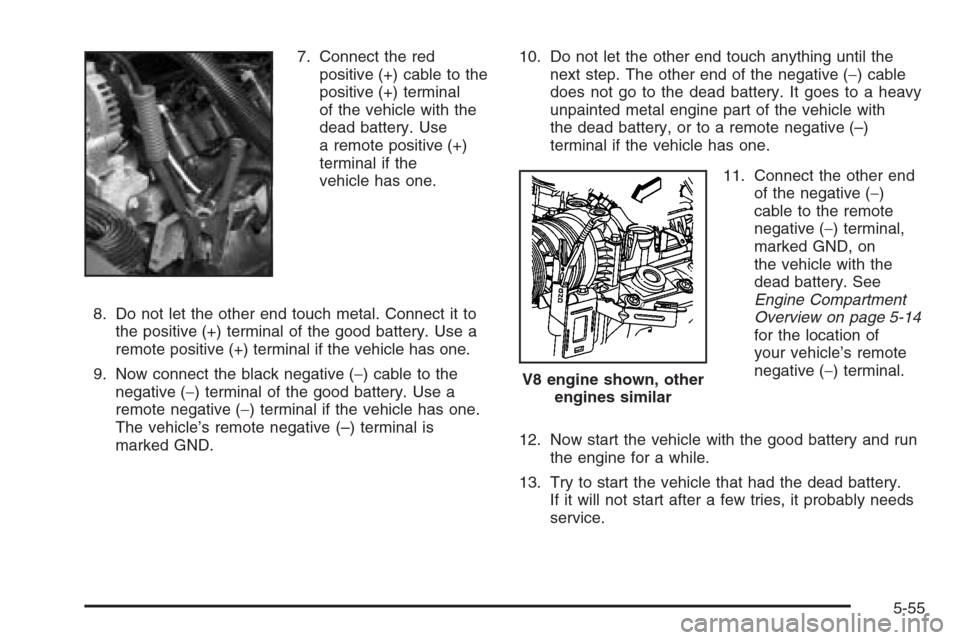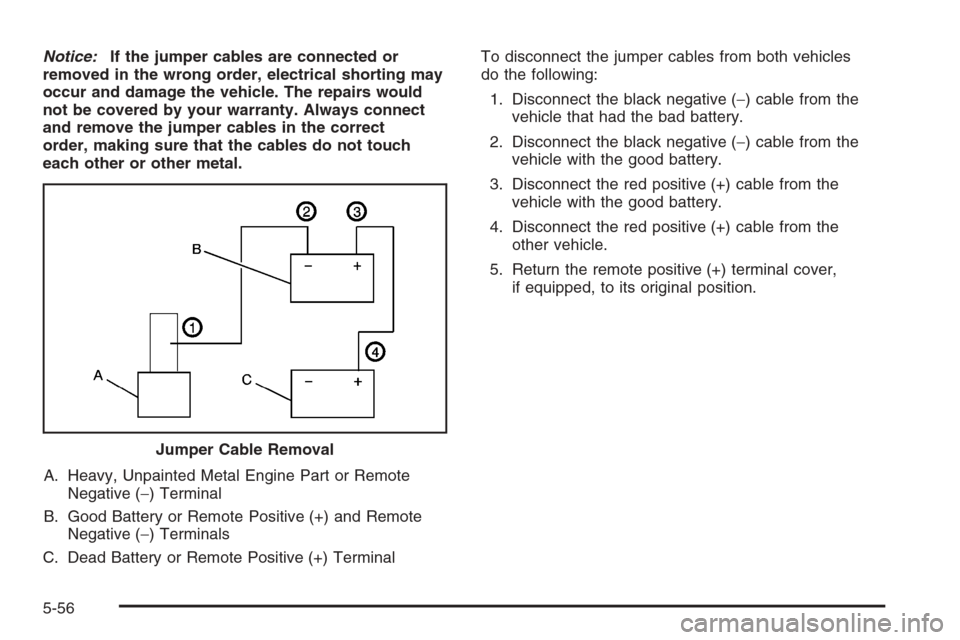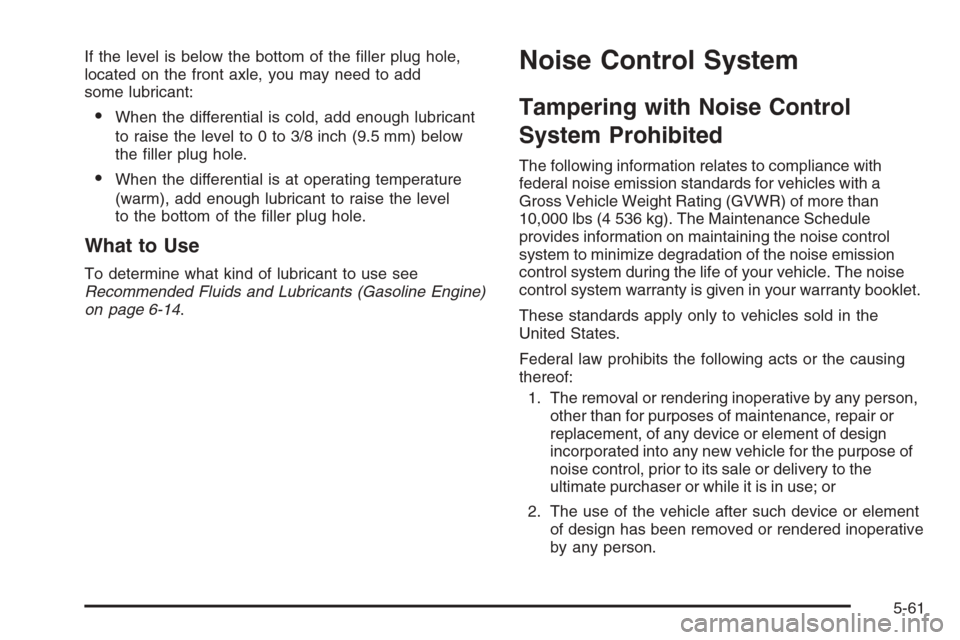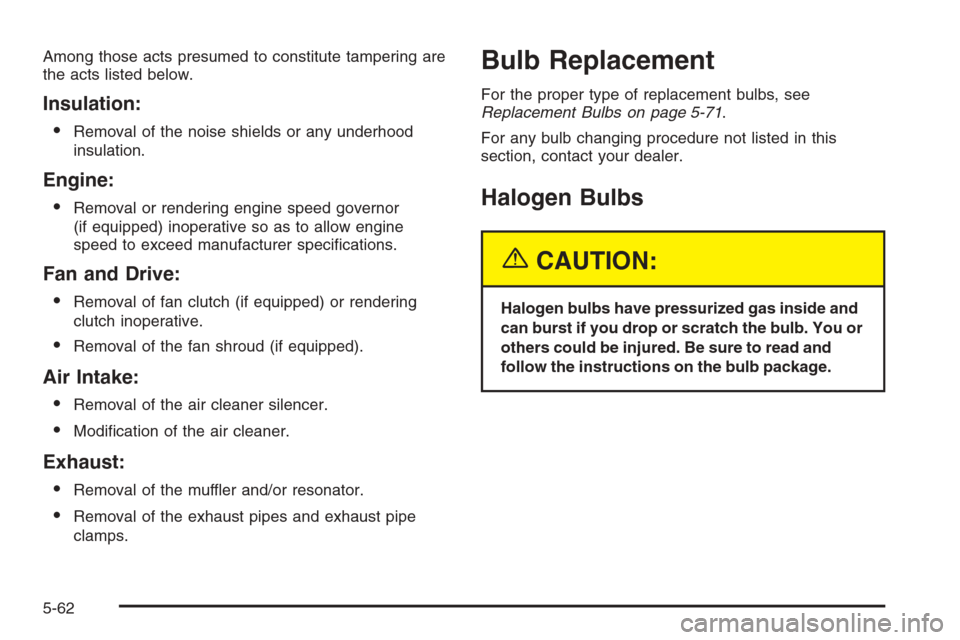Page 453 of 580

7. Connect the red
positive (+) cable to the
positive (+) terminal
of the vehicle with the
dead battery. Use
a remote positive (+)
terminal if the
vehicle has one.
8. Do not let the other end touch metal. Connect it to
the positive (+) terminal of the good battery. Use a
remote positive (+) terminal if the vehicle has one.
9. Now connect the black negative (−) cable to the
negative (−) terminal of the good battery. Use a
remote negative (−) terminal if the vehicle has one.
The vehicle’s remote negative (–) terminal is
marked GND.10. Do not let the other end touch anything until the
next step. The other end of the negative (−) cable
does not go to the dead battery. It goes to a heavy
unpainted metal engine part of the vehicle with
the dead battery, or to a remote negative (–)
terminal if the vehicle has one.
11. Connect the other end
of the negative (−)
cable to the remote
negative (−) terminal,
marked GND, on
the vehicle with the
dead battery. See
Engine Compartment
Overview on page 5-14
for the location of
your vehicle’s remote
negative (−) terminal.
12. Now start the vehicle with the good battery and run
the engine for a while.
13. Try to start the vehicle that had the dead battery.
If it will not start after a few tries, it probably needs
service.
V8 engine shown, other
engines similar
5-55
Page 454 of 580

Notice:If the jumper cables are connected or
removed in the wrong order, electrical shorting may
occur and damage the vehicle. The repairs would
not be covered by your warranty. Always connect
and remove the jumper cables in the correct
order, making sure that the cables do not touch
each other or other metal.
A. Heavy, Unpainted Metal Engine Part or Remote
Negative (−) Terminal
B. Good Battery or Remote Positive (+) and Remote
Negative (−) Terminals
C. Dead Battery or Remote Positive (+) TerminalTo disconnect the jumper cables from both vehicles
do the following:
1. Disconnect the black negative (−) cable from the
vehicle that had the bad battery.
2. Disconnect the black negative (−) cable from the
vehicle with the good battery.
3. Disconnect the red positive (+) cable from the
vehicle with the good battery.
4. Disconnect the red positive (+) cable from the
other vehicle.
5. Return the remote positive (+) terminal cover,
if equipped, to its original position.
Jumper Cable Removal
5-56
Page 455 of 580
All-Wheel Drive
Lubricant checks in this section also apply to these
vehicles. There are two additional systems that need
lubrication.
Transfer Case
When to Check Lubricant
Refer to the Maintenance Schedule to determine how
often to check the lubricant. SeeScheduled
Maintenance (Gasoline Engine) on page 6-4.
How to Check Lubricant
A. Fill Plug B. Drain PlugTo get an accurate reading, the vehicle should be on a
level surface.
If the level is below the bottom of the �ller plug hole,
located on the all-wheel drive transfer case, you’ll need
to add some lubricant. Add enough lubricant to raise
the level to the bottom of the �ller plug hole. Use care
not to overtighten the plug.
What to Use
Refer to the Maintenance Schedule to determine what
kind of lubricant to use. SeeRecommended Fluids
and Lubricants (Gasoline Engine) on page 6-14.
All-Wheel Drive Transfer Case
5-57
Page 456 of 580
Rear Axle
When to Check Lubricant
It is not necessary to regularly check rear axle �uid
unless you suspect there is a leak or you hear an
unusual noise. A �uid loss could indicate a problem.
Have it inspected and repaired.
How to Check Lubricant
To get an accurate reading, the vehicle should be on a
level surface.
The proper level for the 1500 Series is from
5/8 inch to 1 5/8 inch (15 mm to 40 mm) below
the bottom of the �ller plug hole.
The proper level for the 1500HD Series, 2500 Series,
2500HD, and 3500 Series is from 0 to 1/2 inch
(0 to 13 mm) below the bottom of the �ller plug hole.
The proper level for the 1500 and 2500 Series
vehicles with QUADRASTEER™ (4-Wheel Steer)
is from 0 to 1/4 inch (0 to 6 mm) below the �ller
plug hole.
Add only enough �uid to reach the proper level.
What to Use
To determine what kind of lubricant to use see
Recommended Fluids and Lubricants (Gasoline Engine)
on page 6-14.
1500 Series Shown, 2500 Series Similar
5-58
Page 458 of 580
When to Change Lubricant
Refer to the Maintenance Schedule to determine
how often to change the lubricant. SeeScheduled
Maintenance (Gasoline Engine) on page 6-4.
What to Use
Refer to the Maintenance Schedule to determine what
kind of lubricant to use. SeeRecommended Fluids
and Lubricants (Gasoline Engine) on page 6-14.
Front Axle
When to Check Lubricant
It is not necessary to regularly check front axle �uid
unless you suspect there is a leak or you hear an
unusual noise. A �uid loss could indicate a problem.
Have it inspected and repaired.
How to Check Lubricant
To get an accurate reading, the vehicle should be on a
level surface.
5-60
Page 459 of 580

If the level is below the bottom of the �ller plug hole,
located on the front axle, you may need to add
some lubricant:
When the differential is cold, add enough lubricant
to raise the level to 0 to 3/8 inch (9.5 mm) below
the �ller plug hole.
When the differential is at operating temperature
(warm), add enough lubricant to raise the level
to the bottom of the �ller plug hole.
What to Use
To determine what kind of lubricant to use see
Recommended Fluids and Lubricants (Gasoline Engine)
on page 6-14.
Noise Control System
Tampering with Noise Control
System Prohibited
The following information relates to compliance with
federal noise emission standards for vehicles with a
Gross Vehicle Weight Rating (GVWR) of more than
10,000 lbs (4 536 kg). The Maintenance Schedule
provides information on maintaining the noise control
system to minimize degradation of the noise emission
control system during the life of your vehicle. The noise
control system warranty is given in your warranty booklet.
These standards apply only to vehicles sold in the
United States.
Federal law prohibits the following acts or the causing
thereof:
1. The removal or rendering inoperative by any person,
other than for purposes of maintenance, repair or
replacement, of any device or element of design
incorporated into any new vehicle for the purpose of
noise control, prior to its sale or delivery to the
ultimate purchaser or while it is in use; or
2. The use of the vehicle after such device or element
of design has been removed or rendered inoperative
by any person.
5-61
Page 460 of 580

Among those acts presumed to constitute tampering are
the acts listed below.
Insulation:
Removal of the noise shields or any underhood
insulation.
Engine:
Removal or rendering engine speed governor
(if equipped) inoperative so as to allow engine
speed to exceed manufacturer speci�cations.
Fan and Drive:
Removal of fan clutch (if equipped) or rendering
clutch inoperative.
Removal of the fan shroud (if equipped).
Air Intake:
Removal of the air cleaner silencer.
Modi�cation of the air cleaner.
Exhaust:
Removal of the muffler and/or resonator.
Removal of the exhaust pipes and exhaust pipe
clamps.
Bulb Replacement
For the proper type of replacement bulbs, see
Replacement Bulbs on page 5-71.
For any bulb changing procedure not listed in this
section, contact your dealer.
Halogen Bulbs
{CAUTION:
Halogen bulbs have pressurized gas inside and
can burst if you drop or scratch the bulb. You or
others could be injured. Be sure to read and
follow the instructions on the bulb package.
5-62
Page 470 of 580
Windshield Wiper Blade
Replacement
Windshield wiper blades should be inspected for
wear and cracking. SeeScheduled Maintenance
(Gasoline Engine) on page 6-4for more information.
Replacement blades come in different types and
are removed in different ways. For proper type and
length, seeNormal Maintenance Replacement Parts
(Gasoline Engine) on page 6-17.
To replace the windshield wiper blade assembly do the
following:
1. Lift the wiper arm and turn the blade until it is
facing away from the windshield.
2. Push the release lever and slide the wiper assembly
toward the driver’s side of the vehicle.
3. Install a new blade by reversing Steps 1 and 2.
5-72